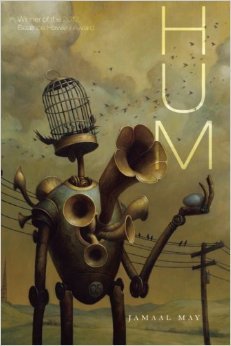Detroit, Michigan has a poet named Jaamal May who sings his city alive. It is a city
of cars and crows, a city where "Sky Now Black with Wings" asks us to reconsider the urban landscape. Born, raised, and residing in Detroit, May is one of the current nominees for the NCAAP Image Award in poetry. He's got my vote, along with that of the twelve students he wowed and inspired at the Environmental Humanities Graduate Program at the University of Utah.
Lately only snippets of news about Detroit, Michigan have been getting through my filters. Detroit is going bankrupt. A powerful 'Financial Manager' has been appointed who thinks selling off city-owned paintings by Monet, Van Gogh, and Rembrandt is good strategy. Vacant homes are given free to artists. And how beautiful I thought their airport was when I changed planes there last summer.
Those filters shattered last weekend as Detroit stripped off its stereotype, becoming a dazzling fountain of inspiration for this young poet. Jamaal was in Salt Lake City leading a workshop for the course, "Art, Advocacy, and Landscape," developed to broaden the scope of environmentalism for a group of grad students eagerly exploring the heightened meaning possible when contributing to the collective good.
Jamaal calls himself a 'working artist,' which spans a broad spectrum. One of America's most talented and recognized slam poets, he has expanded his talents as a writer and performer to the page. His poems can be found in the most prestigious journals. Dozens appear in his book, Hum, published by Alice James Books last year. He teaches, edits, and currently serves as a Kenyon Review Fellow.
During the eight-hour workshop, Jamaal stood, sat, performed, read, and quoted (from Heraclitus to W.S. Merwin). He philosophized and gazed out over us, wondering. We laughed, cried, listened, questioned, pondered and gasped. He had us write. We heard about the world in its flurry of "important, impossible, truths" -- in the context of how a poem happens. We learned that words cannot be things because "every act of communication comes up short" -- there is always an "emotional approximation." We heard about how art connects things. (Why does this threaten our current culture which stigmatizes it for not contributing directly to the production and sale of goods and services?) We learned that poems are "many hinged things" where we discover 'opening after opening after opening.'
As the day ended I felt as if I'd spent it sitting in the sun with my back against a smooth boulder in a wild Wyoming meadow near where I live. I realized that hearing poems read by a magical young poet and talking personally and honestly about the state of things is wild in the sense that a deep place opens inside of us. This "interiority" suggests that new things we desperately need might soon be found.
As one might expect from a poet who lives in and loves Detroit, there are many cars in Hum. One Chrysler "idles so hard the tickle scurries from thigh to earlobe." And hard fixing them has become because "Detroit builds 'em like robots, now." Jamaal has a Venture minivan named "Vendetta," and his father had a Camaro on blocks he "fiddled with daily... refusing to believe its silence."
There is metal in these poems, and machinists and machines, and "mechanophobia" -- the fear of machines. There is one very important gun. Like Detroit, these poems have frogs and flowers--snapdragons. They have stones and the wind blows in them. In one poem ants pour in and out of the gash created in "a melon that has fallen from a bag" and Jamaal wonders if "it takes being broken open and emptied to be filled with something new."
Like most poems, these contain metaphors--"how that thing is like that other thing". Jamaal discussed two types of metaphors: closed where the distance between the two things is close and obvious; and those that are open and the distance is great, requiring the reader work hard to find where that thing and that other thing are connected. A heart "trembling like a herd of horses" is closed more than "standing like a loaded gun." "A damaged eye, closing like a door to a room I could never leave", is wide open and I'm still at work.
Today rereading Hum, the word forgive has become a feathered bird. I dare you to read (or watch ) "Sky made Black with Birds" without wondering, as Jamaal wonders -- "how 'forgive' could ever fit inside my mouth"?
